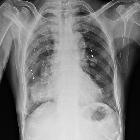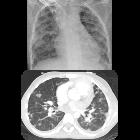cavitating pulmonary metastases







Cavitating pulmonary metastases refer to pulmonary metastases which then tend to cavitate. The term is similar but may not be identical to cystic pulmonary metastases in which the wall of the former may be thicker.
Epidemiology
Cavitation is thought to occur in around 4% of lung metastases .
Pathology
Cavitary pulmonary metastases are most commonly (70%) caused by squamous cell carcinoma, which may of the lung or head and neck . Other primaries are varied and include:
- gastrointestinal adenocarcinomas
- transitional cell carcinoma of bladder
- sarcomas
- cervical cancer
- pancreatic adenocarcinoma : very rare
Cavitating pulmonary metastases have also been reported to develop after chemotherapy, thought to be secondary to tumor necrosis or a valve-effect on an adjacent bronchi .
Treatment and prognosis
Complications
One particular complication that can occur includes the formation of a pneumothorax or a hemopneumothorax.
Differential diagnosis
For multiple cavitating lung lesions (nodules or masses) on imaging consider:
- septic pulmonary emboli
- granulomatosis with polyangiitis
- necrobiotic lung nodules: rare
- pulmonary tuberculosis: upper lobe predominant consolidative region with cavitation
Siehe auch:
- Pneumothorax
- Pneumatozele
- pulmonale Tuberkulose
- Granulomatose mit Polyangiitis
- Kolorektales Karzinom
- septische Embolie Lunge
- Kavernöse Lungenläsionen
- Lungenzysten
- Lungenmetastasen
- necrobiotic lung nodules
- CAVITY
- endometrial stromal sarcoma
- zystische Lungenmetastasen
- pulmonale Bullae
und weiter:

 Assoziationen und Differentialdiagnosen zu kavernisierende Lungenmetastasen:
Assoziationen und Differentialdiagnosen zu kavernisierende Lungenmetastasen:










